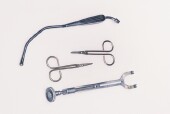
TUESDAY, Oct. 12 (HealthDay News) — Implanting the addiction-treatment drug buprenorphine in people who are opioid-dependent seems to reduce cravings in the short term, researchers say.
By delivering a low but continuous dose of the medication, the implant is designed to reduce the risk that patients addicted to heroin or prescription painkillers (such as Oxycontin) will relapse after missing doses of buprenorphine or simply stop the daily, under-the-tongue treatment altogether.
Dr. Walter Ling, from the University of California, Los Angeles, and his colleagues report their findings in the Oct. 13 issue of the Journal of the American Medical Association.
“In summary, this study found that the use of buprenorphine implants compared with placebo resulted in less opioid use over 16 weeks and also across the full 24 weeks,” the research team said in a news release from the journal.
According to the U.S. National Institute on Drug Abuse, the best way to address opioid addiction is through a combined intervention involving both behavioral (to help patients learn how to cope without drugs) and pharmacological treatments.
Medicinal treatment includes drugs such as naltrexone, methadone and buprenorphine.
The current study involved 163 adults between the ages of 18 and 65 diagnosed as opioid-dependent between 2007 and 2008.
Four buprenorphine delivery devices were implanted under the skin of one arm in 108 patients. Each device was set to slowly release 80 milligrams of medication. The remaining 55 patients received implants without any drug delivery. None of the patients received buprenorphine by the standard oral delivery route.
All the patients received drug counseling for the six months that the devices were in place.
Urine samples taken throughout 16 weeks of treatment revealed that patients given buprenorphine via implants were far less likely to test positive for illicit opioid use than the others.
About 40 percent of the urine samples taken from the implant group tested negative for illegal drug use, compared with about 28 percent of the placebo group.
Also, about two-thirds of those on an implantable buprenorphine regimen stuck to their treatment program for the full six months, while only about 31 percent of those getting no medication did so. None of the buprenorphine patients were deemed to have “failed” their treatment, as opposed to about 31 percent of those not getting the medication.
Despite these findings, Dr. John Mariani, director of the substance treatment and research service at New York State Psychiatric Institute/Columbia University in New York City, expressed some reservations about the innovation.
“First of all, oral treatment is a fantastic therapy,” he said. “It’s a very effective way to deliver treatment, and I would put it up against any other treatment for both substance abuse issues and psychiatric problems.”
“Of course, there will be some patients that have adherence problems with the oral option, for which this would be something to consider,” Mariani said. “But that’s rare. Maybe one in 25 don’t stick to it, whereas the vast majority of patients I treat like the effect of oral buprenorphine and they don’t tend to stop taking it, because then they start to experience withdrawal.”
Mariani noted some drawbacks to the implantable option. “Although it’s not the most invasive procedure to have, it is a surgical approach and there’s always the risk of infection, and then scarring if and when it has to be removed,” he said. “And you can’t individualize the dose, which is very easy to do with the oral drug.”
The introduction of buprenorphine itself changed the landscape of treating opioid dependence, but this delivery system won’t revolutionize treatment, he said. “It adds something to our options, but I don’t think it will be an approach most people will choose.”
More information
For more on opioid-addiction treatment, visit the National Institute on Drug Abuse.

